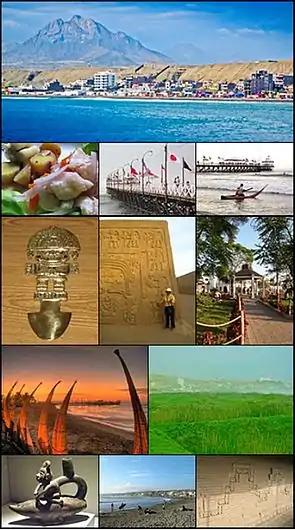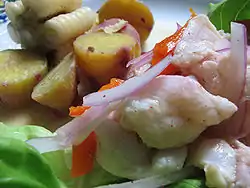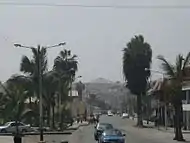Huanchaco
Huanchaco is a popular vacation beach city in province of Trujillo, Peru.[2] Huanchaco is known for its surf breaks, its caballitos de totora and its ceviche, and is near the ancient ruins of Chan Chan. Huanchaco was approved as a World Surfing Reserve by the organization Save The Waves Coalition in 2012 [3] This historic town is part of the tourist circuit called the "Moche Route" or "Ruta Moche".[4]
Huanchaco | |
|---|---|
 From top and left to right: View of Huanchaco beach, Dish of cebiche, Huanchaco pier, Saveguard in Caballito de Totora, Tumi: Chimu work, Chan Chan: Chimu capital, Park in Huanchaco, Night view of the pier, Swamps of Huanchaco, Navegator Chimu in a Caballito de Totora, Surfers in Huanchaco, Wall in Chan Chan | |
 Huanchaco | |
| Coordinates: 7°42.0′S 79°26.0′W | |
| Country | |
| Region | La Libertad Region |
| Province | Trujillo |
| District | Huanchaco |
| Established | Mochica in Pre-Columbian era[1] Spanish: January 1, 1535 by fray Alonso de Escarcena and Juan de Barbaran.[1] |
| Government | |
| • Mayor | Jose Ruiz Vega (2019-2022) |
| Elevation | 13 m (43 ft) |
| Population (2017) | |
| • Urban | 71,379 |
| • Demonym | huanchaquino(a) huanchaqueño(a) |
| Time zone | UTC-5 (PET) |
| Website | Municipality of Huanchaco |
History
Pre-Columbian era
Huanchaco's original population were indigenous fishermen, who worshipped the moon and a golden fish called Huaca Taska. Some accounts suggest the name "Huanchaco" originate from "Gua-Kocha, a Quechua word meaning "beautiful lake". During the period of the Chimú culture, 800 to 1400, Huanchaco was the port for Chan Chan, which was established 4 km away. It was also the main port during Moche period, and was described by Inca Garcilaso de la Vega as the preferred port of the Incas.
Archaeologists led by Gabriel Prieto revealed the largest mass child sacrifice with more than 140 children skeleton and 200 Llamas dating to the Chimú culture after he was informed about some children had found bones in a dune nearby Prieto’s fieldwork in 2011.[5][6]
According to the researchers' notes in the study, there was cut marks on the sterna, or breastbones some of the children and the llamas. Children’s faces were smeared with a red pigment during the ceremony before their chests had been cut open, most likely to remove their hearts.Remains showed that these kids came from different regions and when the children and llamas were sacrificed, the area was drenched with water.[7]
“We have to remember that the Chimú had a very different world view than Westerners today. They also had very different concepts about death and the role each person plays in the cosmos, perhaps the victims went willingly as messengers to their gods, or perhaps Chimú society believed this was the only way to save more people from destruction” said anthropologists Ryan Williams.[8]
Colonial era
Following the Spanish conquest of 1534, the Spanish town was founded as "Huanchaco" on January 1, 1535 by the Franciscan friar Alonso of Escarcena and Juan de Barbaran.
Subsequently, Huanchaco functioned as the main port of Trujillo city, but the port closed in 1870. Two decades later Victor Larco Herrera rebuilt the pier exclusively for exporting sugar from businesses in the neighbouring Chicama valley, one of the most important areas of sugar production in the country.
Origin of Ceviche
According to Andrés Tinoco Rondan, an academic researcher at Ricardo Palma University, Huanchaco is the birthplace of the seafood dish ceviche. Oral histories suggest ceviche was prepared with lemons from Simbal (yunga village nearby), with chilli from the Moche River valley and seaweed extracted from the sea.
In Huanchaco the ceviche is often served to tourists with the seaweed called cochayuyo or mococho which is taken from the shores of Huanchaco[9]
 Typical dish of ceviche in Huanchaco,
Typical dish of ceviche in Huanchaco,
National Cultural Heritage by the Peruvian government
Tourism
Huanchaco is visited by foreign tourists, particularly surfers. Several surf events are held and one of the most important each year in January is the Huanchaco longboard. Other nearby attractions include Chan Chan, Mount Campana, a sacred mountain in the Chimu culture[10] and Pampas de Gramalote, a complex for shamanic experiences.
Surfing
In 2012 Huanchaco obtained approval as a World Surfing Reserve by the organization Save The Waves Coalition. This designation is the first awarded to a Latin America town and the fifth in the world. Huanchaco is notable not only for consistent, smooth waves, but also for being the birthplace of the Caballito de totora boat which is regarded as one of the first known surf crafts.[11] Huanchaco's beaches offer smooth and consistent waves, as it is very exposed to all swells.[12]
The Huanchaco Longboard World Championships is a surfing competition that has taken place since 2010 at the El Elio Beach in Huanchaco, and brings together leading surfers of several countries of the world.[13]
 Surfing in a caballito de totora in Huanchaco
Surfing in a caballito de totora in Huanchaco A group of surfers in Huanchaco
A group of surfers in Huanchaco
Sandboarding
The sand dunes near the town of Laredo, close to Trujillo are a popular destination for sandboarding.
- Huanchaco beach tourist attractions
 Huanchaco beach
Huanchaco beach
surfer's paradise La Ribera avenue at Huanchaco
La Ribera avenue at Huanchaco Peruvian fishing boats
Peruvian fishing boats
It shows the typical and ancient
caballitos de totora Malecon near to the beach
Malecon near to the beach Park in Huanchaco
Park in Huanchaco
Swamps of Huanchaco

Swamps of Huanchaco, also known as Wetlands of Huanchaco[14] is an ecological Chimu reserve located in Huanchaco Beach, about 14 km northwest of Trujillo city, Peru. From this ecological reserve the ancient mochica extracted the raw material for the manufacture of the ancient Caballitos de totora used since the time of the Moche for fishing. Currently Huanchaco fishermen still use materials from these swamps to make the traditional boats[15][16][17]
Festivals
- Carnival of Huanchaco, this carnival has been held since the beginning of the 20th century. Originally villagers performed a carnival emulating the famous Venetian Carnival of the time. Later it became organized by the Club Huanchaco, and now consists of several activities including the crowning of the queen, surf contest, luau party, creativity in the sand, championships of Caballito de totora, and the carnival parade among. In 2012 the carnival parade was held on 25 February.[18]
- San Pedro, the patron saint of fishermen at sea, is also called "San Pedrito"; in Huanchaco it is made a traditional "Patacho" which is a giant reed horse. It is celebrated in the month of June.[19]
See also
- Buenos Aires
- Chan Chan
- Puerto Chicama
- Chimu
- Historic Centre of Trujillo
- La Libertad Region
- Lake Conache
- Las Delicias beach
- Marcahuamachuco
- Moche
- Pacasmayo beach
- Puerto Morín
- Salaverry
- San Jose Festival
- Marinera Festival
- Trujillo Province, Peru
- Trujillo Spring Festival
- Trujillo
- Víctor Larco Herrera District
- Virú culture
- Vista Alegre
- Wetlands of Huanchaco
- Wiraquchapampa
References
- "Huanchaco History" (PDF). Huanchaco Municipality. Retrieved 29 September 2012.
- "Veraneantes ocupan la playa en el inicio del 2013" (PDF). Retrieved January 2, 2013.
- "Huanchaco-World Surfing Reserve in Peru". Archived from the original on 16 November 2012. Retrieved 3 October 2012.
- "Ruta Moche La Libertad" (PDF). Tourism ministry of Peru – MINCETUR (in Spanish). Archived from the original (PDF) on 11 July 2012. Retrieved 3 October 2012.
- "Exclusive: Ancient Mass Child Sacrifice May Be World's Largest". National Geographic News. 2018-04-26. Retrieved 2020-04-26.
- "World's Biggest Mass Child Sacrifice Discovered In Peru, with 140 Killed in 'Heart Removal' Ritual | ARCHAEOLOGY WORLD". Retrieved 2020-04-26.
- March 2019, Laura Geggel 06. "Hearts Ripped from 140 Children and 200 Llamas in Largest Child Sacrifice in Ancient World". livescience.com. Retrieved 2020-04-26.
- EST, Hannah Osborne On 3/6/19 at 2:00 PM (2019-03-06). "World's biggest mass child sacrifice discovered in Peru, with 140 killed in "heart removal" ritual". Newsweek. Retrieved 2020-04-26.
- Peruvian Sea Institute (ed.). "Prospección al recurso cochayuyo en la Playa de Huanchaco" (PDF). Retrieved 2 October 2012.
- "Huanchaco: esta será la nueva propuesta turística en famoso balneario trujillano". 2012-09-25. Retrieved 3 October 2012.
- "Huanchaco-World Surfing Reserve in Peru". Archived from the original on 16 November 2012. Retrieved 3 October 2012.
- "Punta Huanchaco Spot Guide". Magicseaweed.com (in French). Retrieved 2020-02-03.
- RPP (ed.). "Huanchaco se alista para semana de cultura viva y mundial de Longboard" (in Spanish). Retrieved 29 September 2012.
- "Swamps of Huanchaco" (PDF). Retrieved 21 May 2012.
- "Wetlands of Huanchaco". Archived from the original on 1 June 2015. Retrieved 29 May 2012.
- "Day of Wetlands". Retrieved 29 May 2012.
- Victor Pulido. "El Balsar de Huanchaco" (PDF). Retrieved September 2, 2012.
- Newspaper RPP (ed.). "Trujillo: Unos 12 mil turistas disfrutarán del Carnaval de Huanchaco". Retrieved September 13, 2012.
- Newspaper RPP (ed.). "Huanchaco: San Pedro bendice a pescadores en tradicional Patacho". Retrieved September 13, 2012.
External links
| Wikimedia Commons has media related to Huanchaco. |
| Wikimedia Commons has media related to Trujillo (Peru). |
| Wikivoyage has a travel guide for Huanchaco. |
- Location of Huanchaco (Wikimapia)
- "Huaca de la luna and Huaca del sol"
- "Huacas del Sol y de la Luna Archaeological Complex", Official Website
- Information on El Brujo Archaeological Complex
- Chan Chan World Heritage Site, UNESCO
- Chan Chan conservation project
- Website about Trujillo, Reviews, Events, Business Directory
- http://www.huanchacovivo.com
Multimedia
- Huanchaco Longboard on YouTube
- Gallery of Huanchaco by Panoramio, with information of several authors.
- "International Spring Festival in Trujillo" with Miss world 2004 on YouTube
- Tourism in Trujillo city on YouTube
- Marinera Festival 2012 in Trujillo city on YouTube
- Gallery pictures by Panoramio, Includes Geographical information by various authors
- Colonial Trujillo photos

